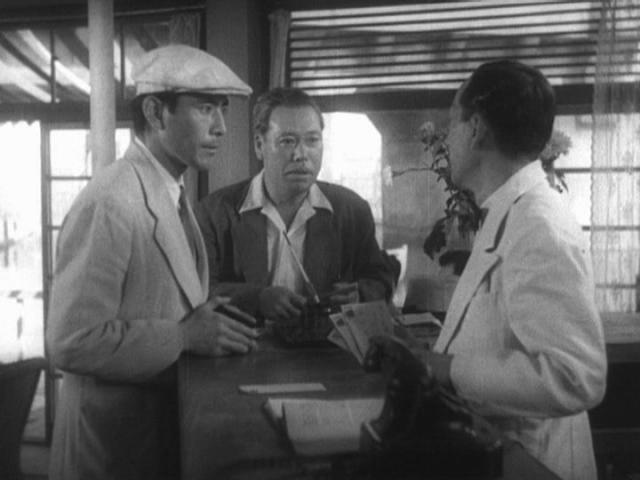|
Genres, Themes, Actors, and Directors:
- Akira Kurosawa Films
- Detectives and Private Eyes
- Japanese Films
- Search
- Veterans
Review:
Akira Kurosawa’s noir-inflected detective flick remains one of the most enduring films in his early oeuvre. Haunted by the fact that his stolen pistol has been used by a desperate thief to kill innocent people, Mifune’s rookie detective (a recent WWII veteran) becomes the embodiment of guilt-ridden determination as he doggedly pursues his leads through the sweltering streets of Tokyo — accompanied by his older, wiser colleague (the always excellent Shimura). Throughout Mifune and Shimura’s hunt, we’re introduced to a host of interesting characters struggling to survive in a post-war environment — most notably Keiko Awaji’s pitiable showgirl “Harumi”, who may be the key link to the murderous pickpocket Mifune is so desperate to capture. Many critics have noted that Stray Dog‘s narrative possesses two strategically contrasting pairs: Mifune and Shimura, of course, form a classic rookie-veteran cop duo, while Mifune and his elusive nemesis “Yusa” (Isao Kimura) are both young veterans whose lives have taken divergent paths after the war — one towards crime, the other towards fighting it. At a little over two hours, Stray Dogs‘s pacing lags occasionally, but Kurosawa infuses his narrative with plenty of exciting sequences (including a particularly memorable, time capsule-worthy baseball game) and strategically frames every shot for maximum effect.
Redeeming Qualities and Moments:
- Takashi Shimura as Detective Sato

- Stunning cinematography and framing

- Effective location shooting (by Inoshiro Honda) in post-war Tokyo

- Keiko Awaji as Harumi
Must See?
Yes, as one of Kurosawa’s early classics.
Categories
- Foreign Gem
- Important Director
Links:
|
3 thoughts on “Stray Dog (1949)”
I’m kind of surprised by my reaction, in a way, but after revisiting this after many years, I’m not feeling it’s a must. It may be one of Kurosawa’s that’s held in high regard, but it’s striking me as form over content, albeit an excellent example of the type.
Kurosawa’s challenge here was to do the best he could with a paper-thin plot – which hinges on the one-note guilt complex of Mifune’s character. (Why can’t this guy get it into his head that he did nothing wrong and nothing is his fault??? Theft happens!) Kurosawa was certainly up to the challenge, and he makes the story as ‘interesting’ as possible by way of his direction, the talents of his cast, and the film’s camerawork.
However, not only does the film take awhile to get going but, once some momentum has kicked in, we find that there really isn’t much of anywhere for the film to go.
Though not called on to do much, Shimura turns in respectable work – but Mifune actually seems miscast and a bit uncomfortable in a role that doesn’t suit him.
You’ll note that I didn’t “call out” Mifune’s performance here, either — for the same reason you mention. And I can relate to your reaction, overall: this is one I appreciate more stylistically and thematically than viscerally. You’ll probably agree with me (something I didn’t mention above, specifically) that the long, long scene on the streets of Tokyo near the beginning of the film — as Mifune begins his search — goes on for TOO long…
Yet I do still find it memorable, and one of his better earlier efforts. I haven’t seen all of Kurosawa’s work by a long shot, but I do vagely recall one earlier film of his (which I watched purely because it was HIS; can’t remember the title at all) which was v-e-r-y slow, and not at all memorable in comparison with this one.
btw: This is neither here nor there but, at one point in the film, some of the action takes place in Koenji (someone mentions it by name). Central Tokyo is actually broken down into little towns. When I first moved to Japan, I lived in Koenji, for a few years. I don’t know how it is there these days but, at the time, it was quite a nice, comfortable little town. Of course, a number of such towns in the area were nice – but I recall Koenji as being particularly cozy.